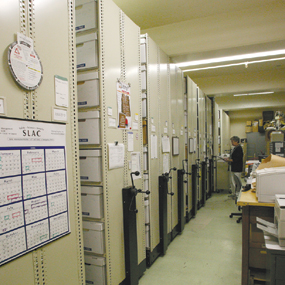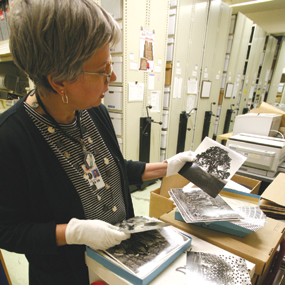Jean Deken: Milestones vs. history
Celebrating a milestone is always enjoyable, but a complete and accurate historical record is invaluable for the past to inform the future.
Looking forward, looking back: An archivist's perspective
Last year the international physics community celebrated "The World Year of Physics." A major reason for the timing of the celebration was that 2005 marked the centennial of Albert Einstein's 1905 "Annus Mirabilis" (Miracle Year), so called because Einstein's three seminal papers–on the photoelectric effect, the size of molecules and Brownian motion, and the theory of relativity–were published in that historic year.
What you might not know or remember is that just two years ago, in 2004, the European particle physics laboratory, CERN, marked its 50th anniversary with a series of public events, a photo contest, an anniversary book of essays and photographs, and an "Open Day" at the lab. And that same year SLAC celebrated the 40th anniversary of its founding with a series of special events, lectures, press releases, and publication of a photo-history book.
As an archivist, I am familiar with this sort of fuss about anniversaries and birthdays, and I have even been known to initiate a bit of commemorative action myself. It is human nature to stop and look back when a milestone has been achieved. Looking back is one way of taking stock, of reviewing the present in the context of the past, and of coming to a better understanding–in the best of instances–of both where one is going, and where one has been. (In addition, legitimate excuses for parties are never to be taken lightly!)
The best milestone celebrations remind old hands, as well as teach new ones coming up, what it is that has become important about their discipline's or organization's past, and what it is about past achievements that still has value in the present day. But a milestone celebration is just another party, however festive it may be, unless the history it celebrates is meaningful, and meaningful history depends upon accuracy in memory, accuracy and completeness in records and documentation, and thoughtful historical analysis.
In his recent book, In Conclusion: A Collection Of Summary Talks In High Energy Physics(2003), James D. Bjorken, Professor Emeritus at SLAC calls such history "rich history," and contrasts it to what he calls the "folk history" phenomenon in particle physics:
"...an increasingly unrealistic viewpoint of the present generation of particle physicists regarding its past. The rich history...is increasingly distilled into a brief folk history. This was originally designed for the non-specialist, but by now is used to teach new generations of students as well. In the folk history, the Standard Model was created as a relatively logical and straightforward process, while in reality it was a tortured one, with many false leads. It is hard for this generation of particle physicists to visualize the rich environment of confusion, and the variety of abandoned alternatives, from which the Standard Model ideology emerged. And it is difficult to now appreciate how hard it was to go from one step to the next..."
While distilled folk history has its place as a vehicle for communicating with non-specialists, rich history is what specialists need, and what archives strive to preserve. Why? Because the accuracy and comprehensiveness of rich history allow it to truly inform both the novice and the expert.
What Bjorken describes about the rich history of the Standard Model is true for the history of other scientific enterprises as well: rich history shows that forward movement is often slow, and that breakthroughs are difficult.
Rich history reminds those who study it that learning occurs even when mistakes are made and sidetracks are followed, and that when you are on them, sidetracks can look very much like main roads for a long time.
Rich history is important because it is real, and its reality can motivate and inspire present-day novices and experts alike, because it reminds them that the way forward has never been clear or easy, and that those who succeed are those who bring a large measure of intelligence, energy, persistence, optimism, and, yes, luck, to bear on their research.
Accuracy and completeness in the historical record, the foundation for rich history, does not mean that everything–every document, every presentation, every web page–has to be preserved. Before the advent of electronic media, the archival rule of thumb was that only 2-5 percent of the paper documentation created by an organization or an individual is truly historically valuable and warrants preservation. In the current age of desktop, laptop, and handheld computing –and of the ubiquitous computer printer– the percentage of paper records deserving longterm preservation has undoubtedly decreased, but the new era presents archives with a new challenge: the need to develop best practices for preserving the small percentage of born-digital records that are historically significant, and that are proving to be much less stable or permanent than their paper-based counterparts.
 |
 |
| Photos: Diana Rogers, SLAC | |
But archives and archivists have centuries of best practices to guide them in the digital era, and the methodologies that the profession has developed and used in the past to appraise and select historically significant records are now being adapted to 20th and 21st century media. One critical difference is that the window of opportunity for the new digital media appears to be significantly smaller than that for paperbased records, which means that in this new era it becomes even more critical for archivists to have the active assistance and collaboration of records creators in the timely identification and selection for preservation of records of interest to present and future historians.
Thoughtful historical analysis can only occur when primary materials (documents, memoirs, images, interviews, etc.) are preserved and are available for research. This is one of the reasons why archivists kick their efforts into overdrive in support of milestone anniversaries and birthdays: their extra efforts are usually rewarded with a better appreciation on the part of their organization, and the public at large, of the rich history of their parent organization; with higher visibility and use of the archives' collections; with greater understanding of the archives' mission; and with the addition of new, or–more accurately–newly re-discovered materials that further enrich the archival collections.
New insights into and understanding of the histories of laboratories, and of the life and works of leading scientists have resulted, and will continue to flow out, from the commemorations of their milestone anniversaries. The books, images, and archival deposits these celebrations engender will continue to inform, instruct, and inspire long after the celebrations themselves have ended.
And in between celebrations, archives continue their work of collecting and preserving present-day records for future use, serving as the bank vaults of rich history and paying dividends in the form of new conversations, new reading, and new thinking about the past. Archivists have a daily appreciation of the fact that the past informs the future, and of the truth of what William Faulkner wrote, that "the past isn't dead, it isn't even past."
Jean Deken
Jean Deken has been the archivist at the Stanford Linear Accelerator Center for 10 years. She is a Charter Member of the Academy of Certified Archivists, and is an investigator in the US National Archives and Records Administration (NARA) Persistent Archives Testbed (PAT) research project to develop methods for archiving historically significant electronic records. She is currently collaborating with W.K.H. Panofsky on the manuscript of a memoir of his life and career. She strongly encourages you to check out the American Institute of Physics Center for the History of Physics web site Scientific Source Materials: Saving Personal Papers and Archival Records in Physics and Allied Fields at http://www.aip.org/history/ source.htm for guidance on dealing with your records.
In the interest of full disclosure, Jean would like to point out that she is a veteran of the SLAC 40th anniversary celebration; the SPEAR 25th anniversary celebration; and the NARA celebration of the 50th anniversary of World War II; and that she is the proud recipient of a bottle of CERN's 50th anniversary wine.
Click here to download the pdf version of this article.


